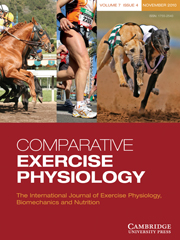Crossref Citations
This article has been cited by the following publications. This list is generated based on data provided by
Crossref.
Murray, Rachel C.
Walters, Juli
Snart, Hannah
Dyson, Sue
and
Parkin, Tim
2010.
How do features of dressage arenas influence training surface properties which are potentially associated with lameness?.
The Veterinary Journal,
Vol. 186,
Issue. 2,
p.
172.
Rogers, Chris
Bolwell, Charlotte
and
Gee, Erica
2012.
Proactive Management of the Equine Athlete.
Animals,
Vol. 2,
Issue. 4,
p.
640.
Wylie, C.E.
Ireland, J.L.
Collins, S.N.
Verheyen, K.L.P.
and
Newton, J.R.
2013.
Demographics and management practices of horses and ponies in Great Britain: A cross-sectional study.
Research in Veterinary Science,
Vol. 95,
Issue. 2,
p.
410.
Campbell, M. L. H.
2013.
When does use become abuse in equestrian sport?.
Equine Veterinary Education,
Vol. 25,
Issue. 10,
p.
489.
Verhaar, Nicole
Rogers, Chris W.
Gee, Erica K.
Bolwell, Charlotte F.
and
Rosanowski, Sarah M.
2014.
The Feeding Practices and Estimated Workload in a Cohort of New Zealand Competition Horses.
Journal of Equine Veterinary Science,
Vol. 34,
Issue. 11-12,
p.
1257.
Lönnell, A. C.
Bröjer, J.
Nostell, K.
Hernlund, E.
Roepstorff, L.
Tranquille, C. A.
Murray, R. C.
Oomen, A.
van Weeren, R.
Bitschnau, C.
Montavon, S.
Weishaupt, M. A.
and
Egenvall, A.
2014.
Variation in training regimens in professional showjumping yards.
Equine Veterinary Journal,
Vol. 46,
Issue. 2,
p.
233.
Robin, C. A.
Ireland, J. L.
Wylie, C. E.
Collins, S. N.
Verheyen, K. L. P.
and
Newton, J. R.
2015.
Prevalence of and risk factors for equine obesity in Great Britain based on owner‐reported body condition scores.
Equine Veterinary Journal,
Vol. 47,
Issue. 2,
p.
196.
Dijkstra, Annette M.
Sinnige, Tjarda C.
Rogers, Chris W.
Gee, Erica K.
and
Bolwell, Charlotte F.
2016.
Preliminary Examination of Farriery and Hoof Care Practices and Owner-Reported Injuries in Sport Horses in New Zealand.
Journal of Equine Veterinary Science,
Vol. 46,
Issue. ,
p.
82.
Druml, Thomas
Dobretsberger, Maximilian
and
Brem, Gottfried
2018.
The Interplay of Performing Level and Conformation—A Characterization Study of the Lipizzan Riding Stallions From the Spanish Riding School in Vienna.
Journal of Equine Veterinary Science,
Vol. 60,
Issue. ,
p.
74.
Williams, Zoë J.
Bertels, Megan
Valberg, Stephanie J.
and
Munderloh, Ulrike Gertrud
2018.
Muscle glycogen concentrations and response to diet and exercise regimes in Warmblood horses with type 2 Polysaccharide Storage Myopathy.
PLOS ONE,
Vol. 13,
Issue. 9,
p.
e0203467.
Wilson, Megan
Williams, Jess
Montrose, V. Tamara
and
Williams, Jane
2019.
Variance in Stallion Semen Quality among Equestrian Sporting Disciplines and Competition Levels.
Animals,
Vol. 9,
Issue. 8,
p.
485.
Bolwell, Charlotte F.
Rogers, Chris W.
Gee, Erica K.
and
Rosanowski, Sarah M.
2020.
Commercial equine production in New Zealand. 3. The racing and sport industries.
Animal Production Science,
Vol. 60,
Issue. 18,
p.
2164.
Gruyaert, M.
Pollard, D.
and
Dyson, S. J.
2020.
An investigation into the occurrence of, and risk factors for, concurrent suspensory ligament injuries in horses with hindlimb proximal suspensory desmopathy.
Equine Veterinary Education,
Vol. 32,
Issue. S10,
p.
173.
Guinnefollau, Lauréline
Gee, Erica K.
Norman, Elizabeth J.
Rogers, Chris W.
and
Bolwell, Charlotte F.
2020.
Horses Used for Educational Purposes in New Zealand: A Descriptive Analysis of Their Use for Teaching.
Animals,
Vol. 10,
Issue. 9,
p.
1547.
Van Herbruggen, Ben
Fontaine, Jaron
Eerdekens, Anniek
Deruyck, Margot
Joseph, Wout
and
De Poorter, Eli
2020.
Feasibility of Wireless Horse Monitoring Using a Kinetic Energy Harvester Model.
Electronics,
Vol. 9,
Issue. 10,
p.
1730.
Chatel, M.M.
and
Williams, J.M.
2021.
What’s in a warm-up? A preliminary investigation of how European dressage riders and show jumpers warm-up their horses for training and at competition.
Comparative Exercise Physiology,
Vol. 17,
Issue. 2,
p.
99.
Tranquille, C.A.
Clarke, J.
Walker, V.A.
and
Murray, R.C.
2021.
A descriptive study quantifying warm-up patterns in elite and non-elite dressage horses in a field environment.
Comparative Exercise Physiology,
Vol. 17,
Issue. 1,
p.
35.
Janczarek, Iwona
Kędzierski, Witold
Tkaczyk, Ewelina
Kaczmarek, Beata
Łuszczyński, Jarosław
and
Mucha, Karolina
2021.
Thermographic Analysis of the Metacarpal and Metatarsal Areas in Jumping Sport Horses and Leisure Horses in Response to Warm-Up Duration.
Animals,
Vol. 11,
Issue. 7,
p.
2022.
Valberg, Stephanie J.
Iglewski, Hailey
Henry, Marisa L.
Schultz, Abigail E.
and
McKenzie, Erica C.
2022.
Skeletal Muscle Fiber Type Composition and Citrate Synthase Activity in Fit and Unfit Warmbloods and Quarter Horses.
Journal of Equine Veterinary Science,
Vol. 118,
Issue. ,
p.
104123.
Antpöhler, Jennifer
and
Barton, Ann Kristin
2025.
Update zu PSSM und MFM – Fokus auf das Warmblut.
pferde spiegel,
Vol. 28,
Issue. 02,
p.
91.

